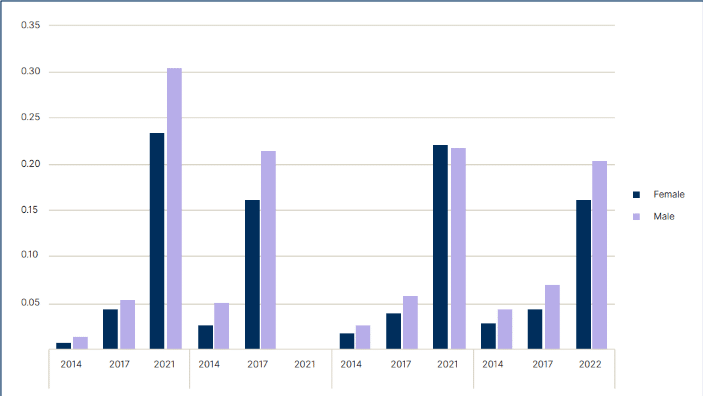Stellar Foundation’s Vision: Empowering the Unbanked Through Blockchain
- Blockchain tech helps more people access affordable banking services, improving their financial stability.
- The recent whitepaper from the Stellar Development Foundation sheds light on how blockchain-based solutions are making a significant impact on the unbanked population and Micro, Small, and Medium Enterprises (MSMEs).
According to a recent analysis of a whitepaper published by the Stellar Development Foundation (SDF), blockchain technology is taking center stage in the global effort to advance financial inclusion. This whitepaper explores the transformative potential of blockchain technology in extending the reach of digital financial services to unbanked and underbanked populations worldwide.
With an estimated 1.4 billion adults worldwide lacking basic financial tools, blockchain-based solutions offer innovative pathways to broaden access to financial services, reduce inequality, and spur economic growth.
Global displacement exceeds 110 million due to climate change, conflicts, and economic hurdles.
Using #blockchain, Stellar Aid Assist empowers people-first solutions in aid delivery. Discover the human impact: ? https://t.co/14wbb03Ai5 #resilientwithblockchain pic.twitter.com/AhW2IKByIQ
— Stellar (@StellarOrg) January 10, 2024
Unlocking Economic Potential through Financial Inclusion
Financial inclusion is a pivotal concept, signifying that individuals and micro, small, and medium-sized enterprises (MSMEs) can access affordable and pertinent financial services tailored to their needs. The SDF’s whitepaper underscores that financial inclusion is not merely about access; it encompasses the ability to actively employ various financial tools and services responsibly and sustainably.
The whitepaper emphasizes that account ownership is the foundational step toward accessing formal financial services. It underscores that households and businesses with financial accounts are better equipped to navigate financial shocks and stabilize their economic well-being. Furthermore, formal financial services offer enhanced security, privacy, and cost-efficiency, making them an attractive alternative to cash-based transactions.
The convergence of digital technology and widespread access to mobile phones and the internet has become a potent force in expanding the reach of financial services. The SDF’s whitepaper highlights the pivotal role played by digital payments, often considered the entry point into the formal financial system. Mobile money services, offered by non-bank financial entities and fintech firms partnering with mobile network operators, have emerged as a vital enabler of financial inclusion, particularly in Sub-Saharan Africa. Notably, these services have empowered women as account owners and active users.
Blockchain’s Value Proposition
Blockchain technology, a decentralized and immutable ledger system, emerges as a game-changing force in advancing financial inclusion. Unlike traditional financial systems, blockchain offers transparent, secure, and efficient cross-border transactions, often at a fraction of the cost. Furthermore, blockchain’s potential extends beyond payments, paving the way for innovative financial products and services that cater to diverse needs.
One of the whitepaper’s significant insights is the pivotal role of blockchain in addressing informality, a critical barrier to financial inclusion. The informal economy, characterized by activities outside formal regulations, often hinders access to financial services. Individuals and MSMEs within the informal sector face difficulties accessing formal lending and expanding their businesses due to a lack of collateral and credit history. Blockchain’s transparent and accessible nature can bridge this gap, offering financial services to those historically excluded.
Despite progress, gender disparities in financial inclusion persist. Women continue to lag in account ownership and face reduced access to financial services compared to men. Additionally, the SDF’s whitepaper underscores the importance of closing this gender gap, emphasizing the need for tailored solutions that empower women economically.

Blockchain-based solutions have the potential to revolutionize financial inclusion by offering secure, efficient, and cost-effective cross-border payments. These solutions reduce transaction costs and enhance transparency and traceability, crucial elements in cash-based transfers and relief efforts during crises.
Innovations on the Horizon
The whitepaper discusses innovative blockchain-based products and initiatives aimed at promoting financial inclusion. These innovations include blockchain-based digital wallets, cross-border payment solutions, and humanitarian aid disbursements. For instance, the collaboration between MoneyGram and the Stellar Development Foundation allows seamless conversion between cash and digital assets, bridging the gap between the physical and digital worlds.
One of the most significant challenges in the financial landscape is the high cost of cross-border payments. However, blockchain solutions are poised to address this issue by offering low-cost and faster cross-border transactions, significantly reducing the financial burden on individuals and businesses.
Furthermore, traditional payment systems often delay settling transactions, leading to inconvenience for consumers and retailers. In contrast, blockchain technology offers real-time payment settlement, providing benefits to payment service providers, consumers, and MSMEs.

Crypto News Flash does not endorse and is not responsible for or liable for any content, accuracy, quality, advertising, products, or other materials on this page. Readers should do their own research before taking any actions related to cryptocurrencies. Crypto News Flash is not responsible, directly or indirectly, for any damage or loss caused or alleged to be caused by or in connection with the use of or reliance on any content, goods, or services mentioned.
Credit: Source link


Comments are closed.